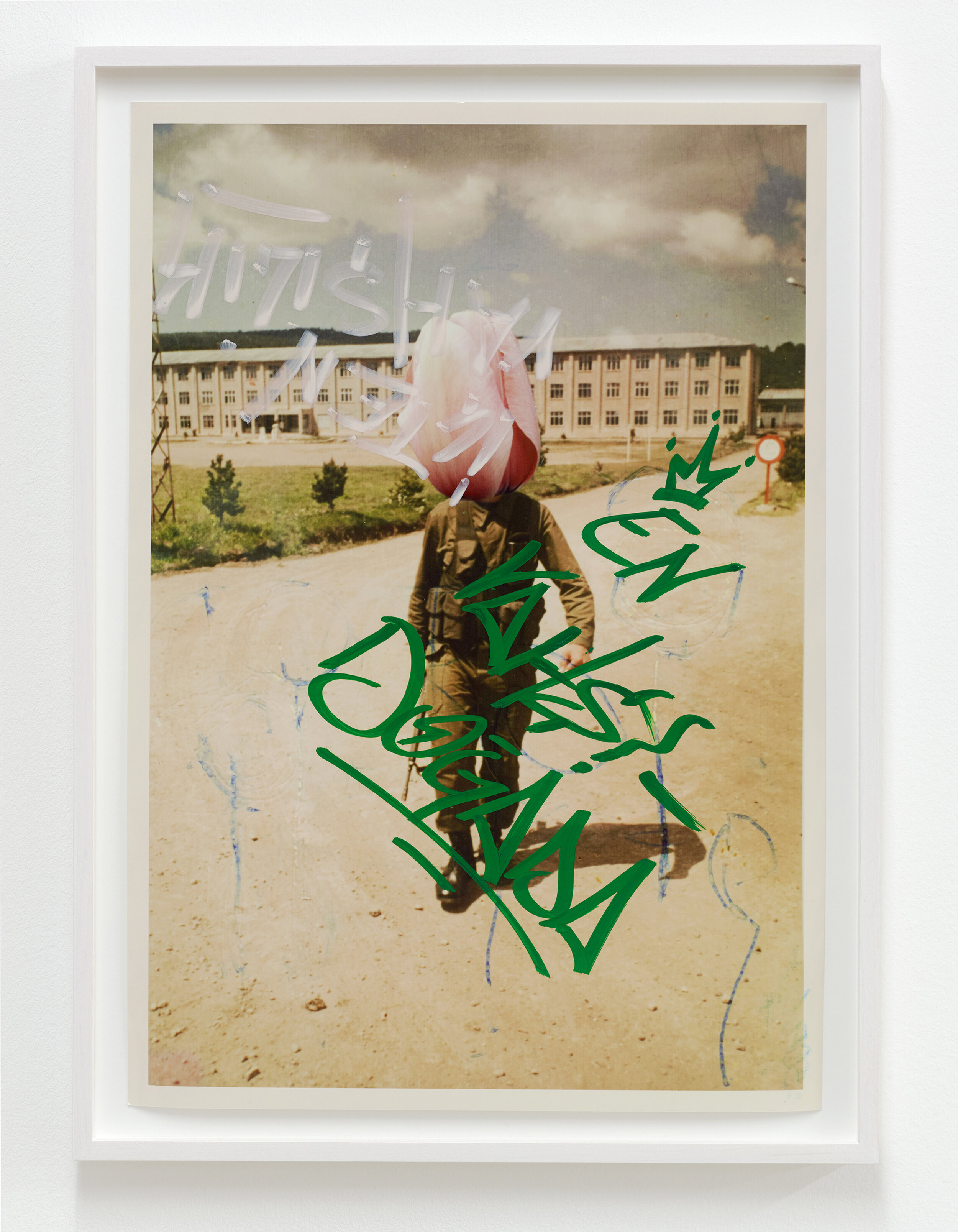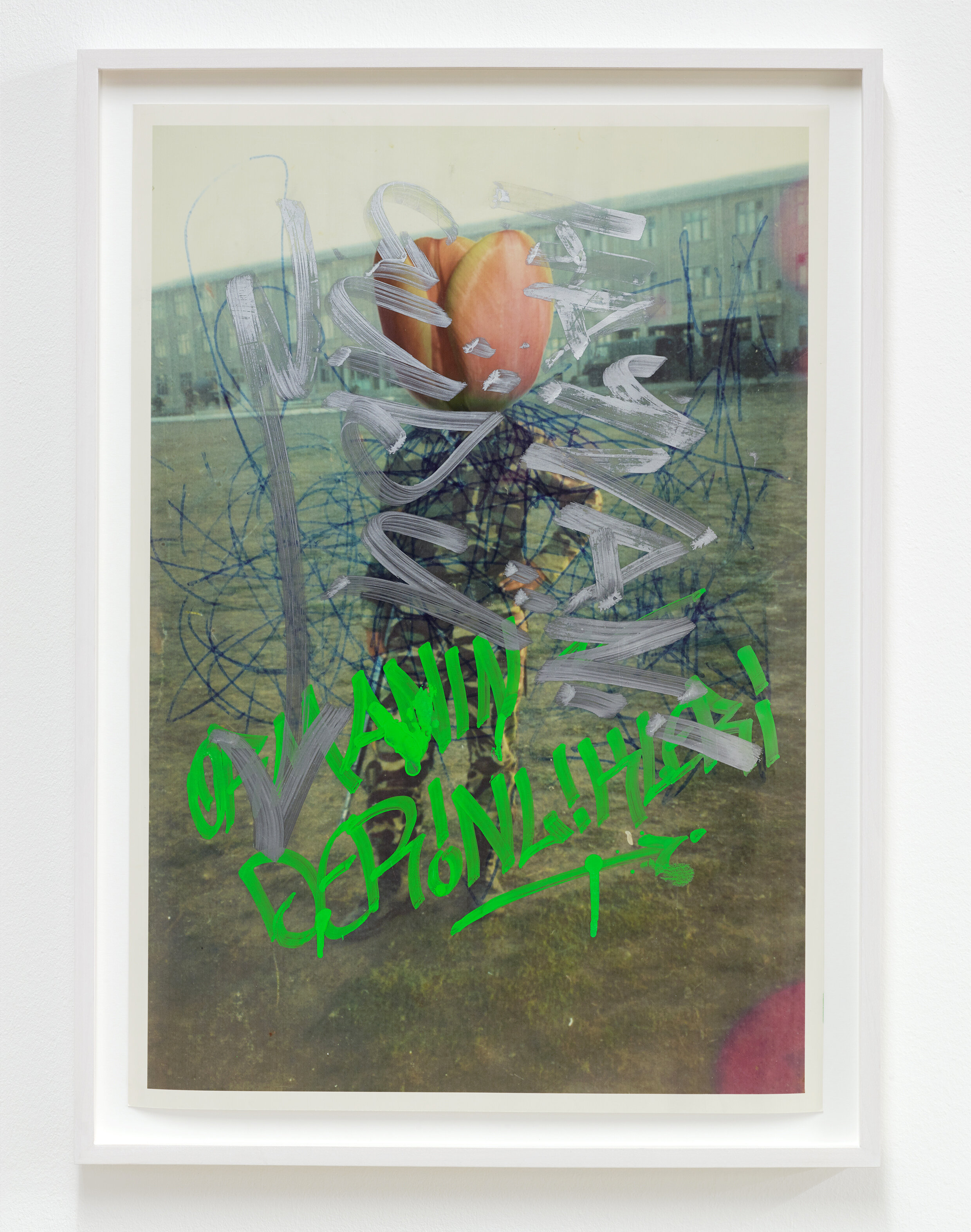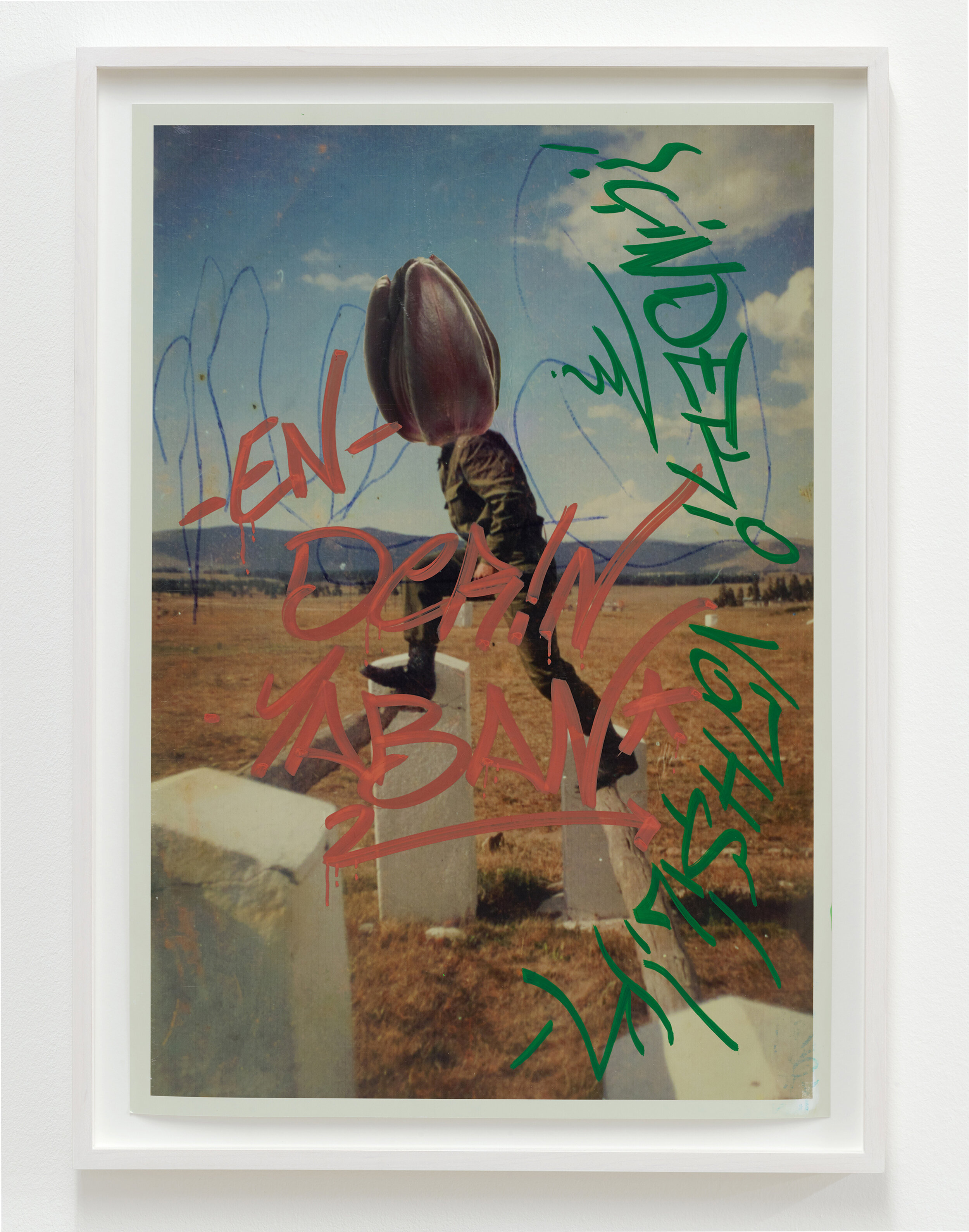The Inmost Wilderness I, II, III, 2017
Marker pen, print, found photos - edited, 50 x 35 cm
The work The Inmost Wilderness – developed during Selma Gültoprak’s residency in Istanbul – shows the results of her research around the cultural significance of the tulip and the garden as a motif, while opening a discourse about the more recent history of Turkey.
The montages consist of found photographs, on which soldiers are posing in front of military architecture in an army training area. The artist drew on the photographs with a ball pen, and took a photo of the photo, which was digitally altered afterwards. Oversized calyxes are placed on the shoulders of the soldiers. The pictures are painted over with handwritten tags, giving various Turkish versions of the art work’s title translated by citizens of Istanbul. Hayvanin Güdü /Içindeki vahşilik/ En derin Yabanı/En vahşi doğası/ Ormanın derinlikeri/ Içindeki vahşilik. The translations are intimate insights of personal interpretations of The Inmost Wilderness and also poetic discoveries about the deepest self of each individual: intimacy, instinct, wilderness, nature, force, beauty and poetry.
The translated titles comment on the underlying pictures, as tags by the assigned Istanbul graffiti artist. Tags, an urban phenomenon of graffiti culture, are originally markings in public spaces to express opinions, reclaiming the streets from the official canon. In this case, the tags decorate collages instead of streets and their rough walls, giving insights into the cultural history of Turkey.
The military in Turkey as a legacy of the state founder Mustafa Kemal Atatürk, is symbolized by and considered as a guardian of the modern republic and laicism. The military coups (1960, 1971, 1980) are still very present in the collective mind of the country. The image of the soldier as an honourable, righteous and modern man and as a representative of harsh and violent policies in the confusions of a bloody civil war, might define this common sense. According to the state, the image of today’s military is changing. The failed coup attempt in the summer of 2016, images of beaten soldiers, the imprisonment of numerous Generals and similar images counteract the pride of the military.
Almost like a giant turban, the calyxes of the tulips embellish the soldiers’ images. The image of the tulip hints at the distant past, when the tulip arrived from Persia in the 15th century into the Osman Empire. During the reign of Sultan Ahmed III, the fascination for tulips and horticulture reached its peak. The time of the tulip (Lale Devri 1718-1730) was reported to be an era of cultural heyday, liberalization and variety, with gardens that were said to be revolutionary. The public parks were transformed into spaces of encounter, exchange, and even a place for flirtation between the social-classes.
Selma Gültoprak opens a discourse about militarism, (Neo-)Ottomanism and deep socio-political Turkish conflict lines in her work The Inmost Wilderness. Furthermore, in her pictures she asks questions about public spaces, the rewriting and overwriting of history and stories, how we are intertwined in them, and also about the ambivalence of culture and nature. The collages offer an insight into the artist’s work in progress, where she combines her research for artistic motifs and personal discoveries.
Text: Eva Liedtjens M.A.
The image The Inmost Wilderness connects content and form with various layers and times: a found photograph and language as documents of time, digital editing, pen scribbles and a graffiti tag as techniques. The series of pictures reflect the superimposition of Turkish history, its meaning and its change over time.
The tulip is the unofficial emblem of Turkey. Since the time of the Ottoman Empire the tulip has been called “Lale”. The word is a part of the word for god (Allah) and stands since then, inter alia, for paradise and eternal life. Especially during the reign of Sultan Ahmet III - the aficionado of gardening and plants, and above all the tulip (lale) – who in the beginning of the 18th century ordered architects to build shared public spaces: a revolutionary idea at the time. Ever since gardens were open to the public, people from different social-classes have been coming together, getting to know each other, and exchanging ideas between one other. The cultural diversity and liberalization was significant during the reign of Sultan Ahmed (also with book printing and miniature painting techniques) – this time was called lale devri ‘era of the tulips’. Architects integrated pavilions, paths and fountains into the surrounding nature of the gardens. Nowadays, the public parks play a large role in urban areas, as a place for recovery, for getting together and for recreation and leisure. Parks and gardens offer a place for imagining a small paradise in an ideal world.
The elements in the Inmost Wilderness create a mystic transformation while addressing the cross-layers of genuine “symbols” of Turkey. Integrating the graffiti makes one think of the marking of public spaces. With the focus on Turkey, together with the tulip and the garden as a man-made space for get-togethers and the military, the tag elicits the memory in the viewer of the occupation of Gezi park, a public space on which, according to recent plans, the former military barracks are planned to be rebuilt.
Interestingly enough, today the Turkish military occupies one of the nicest locations in Istanbul, often untouched and park like, but by all means non-accessible to the public. There are military locations along the Bosporus river for example, or on the prince islands, where one can assume a hidden paradise from afar. The military has a special role in Turkey, being a hermetic system that owns and trades internationally across several influential industries. Today however, the power of the military is decreasing.
The word military is the synonym for a number of relatives of the army – represented as soldiers in The Inmost Wilderness who are anonymised in the personal photos. (Tulips as clones.) The military also represents an understanding of territory and questions of property, as well as safety and domestic security.
The title The Inmost Wilderness and its numerous translated versions in Turkish, signifies an understanding of nature, of humanity or animalism within, or what remained of the animalism within. The English term “inmost” is an old word for “the most secret and personal/ the deepest”.
The change of spaces, especially public spaces, forming us and our movements within them, stays in constant exchange with our inner space – overlapping each other.
The series The Inmost Wilderness I, II, III shows an overlay of symbols, gestures and words, and mixes their separated codes into a story that links to and arranges a poetic image.
Text: Selma Gültoprak



Photo: Simon Vogel